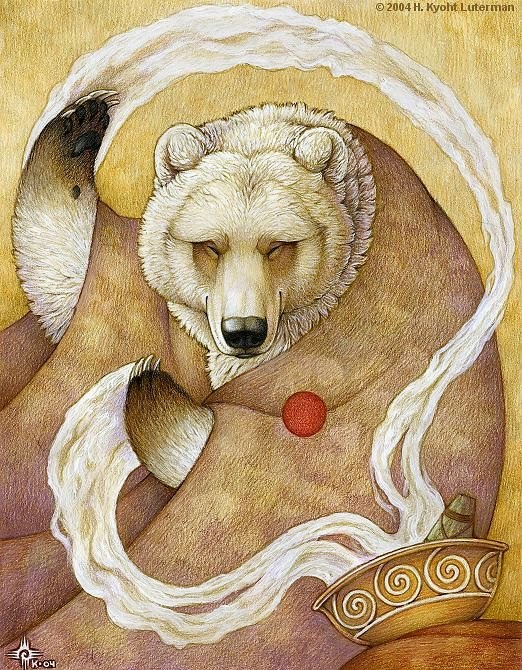Origin of Dolphins
Chumash
According to legend, Chumash who fell into the ocean while crossing the rainbow to the mainland were turned into dolphins.
Channel Islands National Park Hutash, the Earth Mother, created the first Chumash people on the island of Limuw, now known as Santa Cruz Island. They were made from the seeds of a Magic Plant.
Hutash was married to the Alchupo’osh, Sky Snake, the Milky Way, who could make lightning bolts with his tongue. One day he decided to make a gift to the Chumash people. He sent down a bolt of lightning that started a fire. After this, people kept fires burning so that they could keep warm and cook their food.
In those days, the Condor was a white bird. The Condor was very curious about the fire he saw burning in the Chumash village. He wanted to find out what it was. He flew very low over the fire to get a better look, but he flew too close; he got his feathers scorched, and they turned black. Now the Condor is a black bird, with just a little white left under the wings where they did not get burned.
After Alchupo’osh gave them fire, the Chumash people lived more comfortably. More people were born each year and their villages got bigger and bigger. Limuw was getting crowded. And the noise people made was starting to annoy Hutash. It kept her awake at night. So, finally, she decided that some of the Chumash people had to move off the island. They would have to go to the mainland, where there weren’t any people living in those days.
But how were the people going to get across the water to the mainland? Finally, Hutash had the idea of making a bridge out of a wishtoyo (rainbow). She made a very long, very high rainbow that stretched from the tallest mountain on Limuw all the way to Tzchimoos, the tall mountain near Mishopshno (Carpinteria).
Hutash told the people to go across the rainbow bridge and to fill the whole world with people. So the Chumash people started to go across the bridge. Some of them got across safely, but some people made the mistake of looking down. It was a long way down to the water, and the fog was swirling around. They became so dizzy that some of them fell off the rainbow bridge, down through the fog, into the ocean. Hutash felt very badly about this because she told them to cross the bridge. She did not want them to drown. To save them, she turned them into dolphins. Now the Chumash call the dolphins their brothers and sisters.
Excerpted from:
The Chumash People: Materials for Teachers and Students. Santa Barbara, CA: Santa Barbara Museum of Natural History, 1991.
Chumash
According to legend, Chumash who fell into the ocean while crossing the rainbow to the mainland were turned into dolphins.
Channel Islands National Park Hutash, the Earth Mother, created the first Chumash people on the island of Limuw, now known as Santa Cruz Island. They were made from the seeds of a Magic Plant.
Hutash was married to the Alchupo’osh, Sky Snake, the Milky Way, who could make lightning bolts with his tongue. One day he decided to make a gift to the Chumash people. He sent down a bolt of lightning that started a fire. After this, people kept fires burning so that they could keep warm and cook their food.
In those days, the Condor was a white bird. The Condor was very curious about the fire he saw burning in the Chumash village. He wanted to find out what it was. He flew very low over the fire to get a better look, but he flew too close; he got his feathers scorched, and they turned black. Now the Condor is a black bird, with just a little white left under the wings where they did not get burned.
After Alchupo’osh gave them fire, the Chumash people lived more comfortably. More people were born each year and their villages got bigger and bigger. Limuw was getting crowded. And the noise people made was starting to annoy Hutash. It kept her awake at night. So, finally, she decided that some of the Chumash people had to move off the island. They would have to go to the mainland, where there weren’t any people living in those days.
But how were the people going to get across the water to the mainland? Finally, Hutash had the idea of making a bridge out of a wishtoyo (rainbow). She made a very long, very high rainbow that stretched from the tallest mountain on Limuw all the way to Tzchimoos, the tall mountain near Mishopshno (Carpinteria).
Hutash told the people to go across the rainbow bridge and to fill the whole world with people. So the Chumash people started to go across the bridge. Some of them got across safely, but some people made the mistake of looking down. It was a long way down to the water, and the fog was swirling around. They became so dizzy that some of them fell off the rainbow bridge, down through the fog, into the ocean. Hutash felt very badly about this because she told them to cross the bridge. She did not want them to drown. To save them, she turned them into dolphins. Now the Chumash call the dolphins their brothers and sisters.
Excerpted from:
The Chumash People: Materials for Teachers and Students. Santa Barbara, CA: Santa Barbara Museum of Natural History, 1991.



